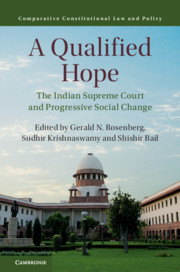Book contents
- A Qualified Hope
- Comparative Constitutional Law and Policy
- A Qualified Hope
- Copyright page
- Contents
- Notes on Contributors
- Foreword
- Acknowledgments
- Introduction
- Part I The Supreme Court of India – An Institutional Overview
- 1 The Structure and Functioning of the Supreme Court of India
- 2 The Supreme Court of India
- 3 The Recent Evolution of Public Interest Litigation in the Indian Supreme Court
- 4 Suo Motu Intervention and the Indian Judiciary
- 5 Public Trust in the Indian Judiciary
- Part II The Supreme Court of India, Social and Political Mobilization
- Part III Welfare Rights and the Environment
- Part IV Discrimination
- Conclusion
- References
5 - Public Trust in the Indian Judiciary
The Power to Transform
from Part I - The Supreme Court of India – An Institutional Overview
Published online by Cambridge University Press: 19 August 2019
- A Qualified Hope
- Comparative Constitutional Law and Policy
- A Qualified Hope
- Copyright page
- Contents
- Notes on Contributors
- Foreword
- Acknowledgments
- Introduction
- Part I The Supreme Court of India – An Institutional Overview
- 1 The Structure and Functioning of the Supreme Court of India
- 2 The Supreme Court of India
- 3 The Recent Evolution of Public Interest Litigation in the Indian Supreme Court
- 4 Suo Motu Intervention and the Indian Judiciary
- 5 Public Trust in the Indian Judiciary
- Part II The Supreme Court of India, Social and Political Mobilization
- Part III Welfare Rights and the Environment
- Part IV Discrimination
- Conclusion
- References
Summary
The dominant accounts of the Indian Supreme Court’s capacity for social transformation place considerable emphasis on the exceptional public trust and confidence in the Indian judiciary. Using National Election Studies post election survey data collected following the 1996 and 2009 Parliamentary elections, this is the first study to evaluate and assess the nature and extent of trust in Indian courts using public opinion data. We find that Indians have remarkably high levels of trust and confidence in the Indian judiciary across socio-demographic factors and consistently across the two time periods examined in this study. Secondly, we find that standard explanations based on caste and religious identity do not find purchase when explaining trust in the judiciary. Nor does class status. Finally, we find that trust in elected institutions is positively associated with trust in the judiciary providing preliminary support for the institutional legitimacy or a diffuse support hypothesis. We conclude that the Indian judiciary enjoys significant public trust and confidence, that provides the institutional legitimacy for an innovative and radical approach to constitutional adjudication.
Keywords
- Type
- Chapter
- Information
- A Qualified HopeThe Indian Supreme Court and Progressive Social Change, pp. 123 - 140Publisher: Cambridge University PressPrint publication year: 2019
References
- 3
- Cited by



